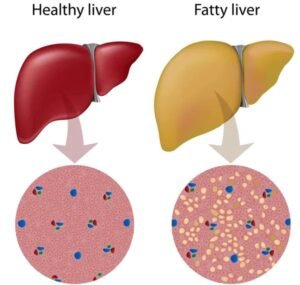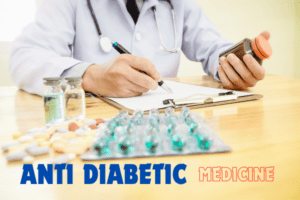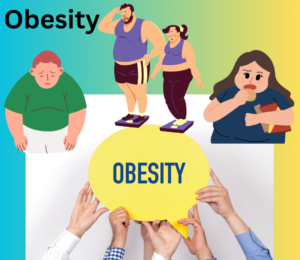The Silent Cry of Your Liver: Fatty Liver and the Threat of a Higher Death Rate
People often imagine their liver as a strong workhorse that quietly gets rid of toxins and keeps our bodies running smoothly. What happens, though, when that important part gets too fat? The answer is, sadly, scarier than most people think. Fatty liver disease (NAFLD), a situation in which the liver stores too much fat, is not just a problem in one place. There is a big problem with the system that makes a lot of people more likely to die from a lot of diseases that don’t seem to be connected.
The Silent Epidemic: The Growing Threat of NAFLD
Like the rise in fat, type 2 diabetes, and metabolic syndrome, NAFLD is becoming more common. What’s scary is that it often starts without any obvious signs, so it can spread quietly until it gets to more advanced stages. Because it gets worse slowly, many people don’t know they have it until it’s too late, which is a dangerous health worry.
 Beyond the Liver: The Dangerous Chain of Events
Beyond the Liver: The Dangerous Chain of Events
A new study has found an unsettling connection between NAFLD and a higher risk of death from a wide range of causes, not just liver problems. This link shows how a fatty liver affects the whole body and how it can be used to guess about someone’s health in general. It’s not just harm to the liver; it has a chain reaction effect on the whole body.
Heart Disease: The Partner of the Silent Killer
Heart attacks, strokes, and other types of cardiovascular disease (CVD) are still the top cause of death in the world.
This link between NAFLD and a higher chance of CVD is strong, even when we take into account common risk factors like high cholesterol and blood pressure.
This link is complicated because it involves insulin resistance, long-term inflammation, and changes in how fats are used in the body. These things make atherosclerosis worse, which is when plaque builds up in the arteries.
In essence, a fatty liver makes conditions that encourage heart damage more likely, which increases the risk of death.
A Hidden Risk of Cancer
Advanced NAFLD can lead to liver cancer, but studies have also found a link between the condition and a higher chance of other cancers, such as colorectal, pancreatic, and breast cancer.
Chronic inflammation, insulin resistance, and hormonal changes that are linked to NAFLD may help cancer grow.
Researchers are still trying to figure out how this happens, but there is strong evidence that having a fatty liver increases your risk of getting cancer.
 Type 2 diabetes: Two Bad Guys
Type 2 diabetes: Two Bad Guys
Type 2 diabetes and NAFLD are closely linked, making a harmful loop. Insulin resistance, which is a key part of both illnesses, makes them worse.
People who already have NAFLD are more likely to get type 2 diabetes, and people who have both diseases are even more likely to have problems with their eyes, nerves, or kidneys.
In turn, these problems raise the risk of dying too soon.
A Quiet Partnership for People with Chronic Kidney Disease
The liver and kidneys are linked, so if one organ doesn’t work right, it can affect the other.
NAFLD has been found to be a risk factor for chronic kidney disease (CKD) on its own.
No one knows for sure how NAFLD hurts the kidneys, but it is thought that inflammation and metabolic problems that happen because of it can do so.
This link means that having a big liver can make you more likely to get kidney disease, which is a very bad health problem that can also make you die faster.
More likely to get infections:
A weak defense system has been linked to NAFLD.
This means that people with a fatty liver are more likely to get illnesses, which can raise their risk of death, especially if they already have other health problems.
Protecting Your Liver and Your Life: Taking Charge
Good news: NAFLD can often be fixed, especially when it is very early on. You can greatly lower your risk and improve your health by making changes to the way you live.
Adopt a healthy eating plan:
Fruits, veggies, whole grains, lean protein, and other unprocessed foods should be your main focus.
Cut back on prepared foods, sugary drinks, and saturated and trans fats.
A Mediterranean diet might help people with NAFLD.
 Make regular exercise a priority:
Make regular exercise a priority:
Aim to do 150 minutes of aerobic exercise at a mild level or 75 minutes of aerobic exercise at a vigorous level each week.
Exercise makes insulin work better, lowers fat in the liver, and is good for your health in general.

Stay at a healthy weight:
If you are overweight or fat, even a small amount of weight loss can make a big difference in the health of your liver.
Take care of the underlying conditions:
If you have diabetes, high cholesterol, or any other health problem, you should work with your doctor to take care of it properly.
 Limit your drinking of alcohol:
Limit your drinking of alcohol:
Even drinking a small amount of booze can hurt your liver.
Keep getting checkups:
Getting regular checkups with a doctor can help find NAFLD early and track its growth.
Pay attention to what your body is saying.
Our bodies are trying to tell us things, and we need to pay attention. Putting liver health first isn’t just a way to avoid getting liver disease; it’s also a way to protect your overall health and lower your risk of dying from many other major illnesses. You can take better care of your liver and live a longer, healthier life by making good choices every day.

